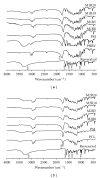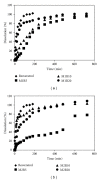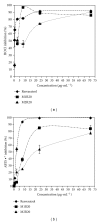PHBV/PCL microparticles for controlled release of resveratrol: physicochemical characterization, antioxidant potential, and effect on hemolysis of human erythrocytes
- PMID: 22666135
- PMCID: PMC3361330
- DOI: 10.1100/2012/542937
PHBV/PCL microparticles for controlled release of resveratrol: physicochemical characterization, antioxidant potential, and effect on hemolysis of human erythrocytes
Abstract
Microparticles of poly(3-hydroxybutyrate-co-3-hydroxyvalerate) (PHBV) and poly(ε-caprolactone) (PCL) containing resveratrol were successfully prepared by simple emulsion/solvent evaporation. All formulations showed suitable encapsulation efficiency values higher than 80%. PHBV microparticles revealed spherical shape with rough surface and presence of pores. PCL microparticles were spherically shaped with smooth surface. Fourier-transformed infrared spectra demonstrated no chemical bond between resveratrol and polymers. X-ray powder diffraction patterns and differential scanning calorimetry analyses indicated that microencapsulation led to drug amorphization. These PHBV/PCL microparticles delayed the dissolution profile of resveratrol. Release profiles were better fitted to biexponential equation. The hypochlorous-acid-scavenging activity and 2,2-azinobis(3-ethylbenzothiazoline-6-sulfonic acid) radical cation discoloration assay confirmed that the antioxidant activity of PHBV/PCL microparticles was kept, but was dependent on the microparticle morphology and dissolution profile. Resveratrol-loaded PHBV/PCL microparticles showed no cytotoxic effect on red blood cells.
Figures










Similar articles
-
PCL/PHBV microparticles as innovative carriers for oral controlled release of manidipine dihydrochloride.ScientificWorldJournal. 2014 Jan 16;2014:268107. doi: 10.1155/2014/268107. eCollection 2014. ScientificWorldJournal. 2014. PMID: 24550699 Free PMC article.
-
Microparticles prepared with poly(hydroxybutyrate-co-hydroxyvalerate) and poly(epsilon-caprolactone) blends to control the release of a drug model.J Microencapsul. 2007 Mar;24(2):175-86. doi: 10.1080/02652040701233556. J Microencapsul. 2007. PMID: 17454428
-
Development and evaluation of poly(3-hydroxybutyrate-co-3-hydroxyvalerate) and polycaprolactone microparticles of nimodipine.Curr Pharm Des. 2013;19(41):7264-70. doi: 10.2174/138161281941131219125657. Curr Pharm Des. 2013. PMID: 23489204
-
Adapalene-loaded poly(ε-caprolactone) microparticles: Physicochemical characterization and in vitro penetration by photoacoustic spectroscopy.PLoS One. 2019 Mar 21;14(3):e0213625. doi: 10.1371/journal.pone.0213625. eCollection 2019. PLoS One. 2019. PMID: 30897170 Free PMC article.
-
Effects of crystalline microstructure on drug release behavior of poly(epsilon-caprolactone) microspheres.J Control Release. 2003 Oct 30;92(3):249-58. doi: 10.1016/s0168-3659(03)00367-5. J Control Release. 2003. PMID: 14568406
Cited by
-
Surface Modification of SPIONs in PHBV Microspheres for Biomedical Applications.Sci Rep. 2018 May 8;8(1):7286. doi: 10.1038/s41598-018-25243-9. Sci Rep. 2018. PMID: 29739955 Free PMC article.
-
Polycaprolactone scaffold engineered for sustained release of resveratrol: therapeutic enhancement in bone tissue engineering.Int J Nanomedicine. 2014;9:183-95. doi: 10.2147/IJN.S49460. Epub 2013 Dec 23. Int J Nanomedicine. 2014. PMID: 24399875 Free PMC article.
-
The Role of Plant-Derived Natural Products as a Regulator of the Tyrosine Kinase Pathway in the Management of Lung Cancer.Curr Issues Mol Biol. 2025 Jun 30;47(7):498. doi: 10.3390/cimb47070498. Curr Issues Mol Biol. 2025. PMID: 40728967 Free PMC article. Review.
-
Effect of Hydroxyapatite Microspheres, Amoxicillin-Hydroxyapatite and Collagen-Hydroxyapatite Composites on Human Dental Pulp-Derived Mesenchymal Stem Cells.Materials (Basel). 2021 Dec 8;14(24):7515. doi: 10.3390/ma14247515. Materials (Basel). 2021. PMID: 34947112 Free PMC article.
-
PCL/PHBV microparticles as innovative carriers for oral controlled release of manidipine dihydrochloride.ScientificWorldJournal. 2014 Jan 16;2014:268107. doi: 10.1155/2014/268107. eCollection 2014. ScientificWorldJournal. 2014. PMID: 24550699 Free PMC article.
References
-
- Karacay Ö, Sepici-Dincel A, Karcaaltincaba D, et al. A quantitative evaluation of total antioxidant status and oxidative stress markers in preeclampsia and gestational diabetic patients in 24–36 weeks of gestation. Diabetes Research and Clinical Practice. 2010;89(3):231–238. - PubMed
-
- Pandey KB, Rizvi SI. Resveratrol may protect plasma proteins from oxidation under conditions of oxidative stress in vitro. Journal of the Brazilian Chemical Society. 2010;21(5):909–913.
-
- Premkumar K, Bowlus CL. Ascorbic acid reduces the frequency of iron induced micronuclei in bone marrow cells of mice. Mutation Research—Genetic Toxicology and Environmental Mutagenesis. 2003;542(1-2):99–103. - PubMed
-
- Barreiros ALBS, David JM, David JP. Estresse oxidativo: relação entre geração de espécies reativas e defesa do organismo. Quimica Nova. 2006;29(1):113–123.
-
- Shi G, Rao L, Yu H, Xiang H, Yang H, Ji R. Stabilization and encapsulation of photosensitive resveratrol within yeast cell. International Journal of Pharmaceutics. 2008;349(1-2):83–93. - PubMed
MeSH terms
Substances
LinkOut - more resources
Full Text Sources
Other Literature Sources
Medical

